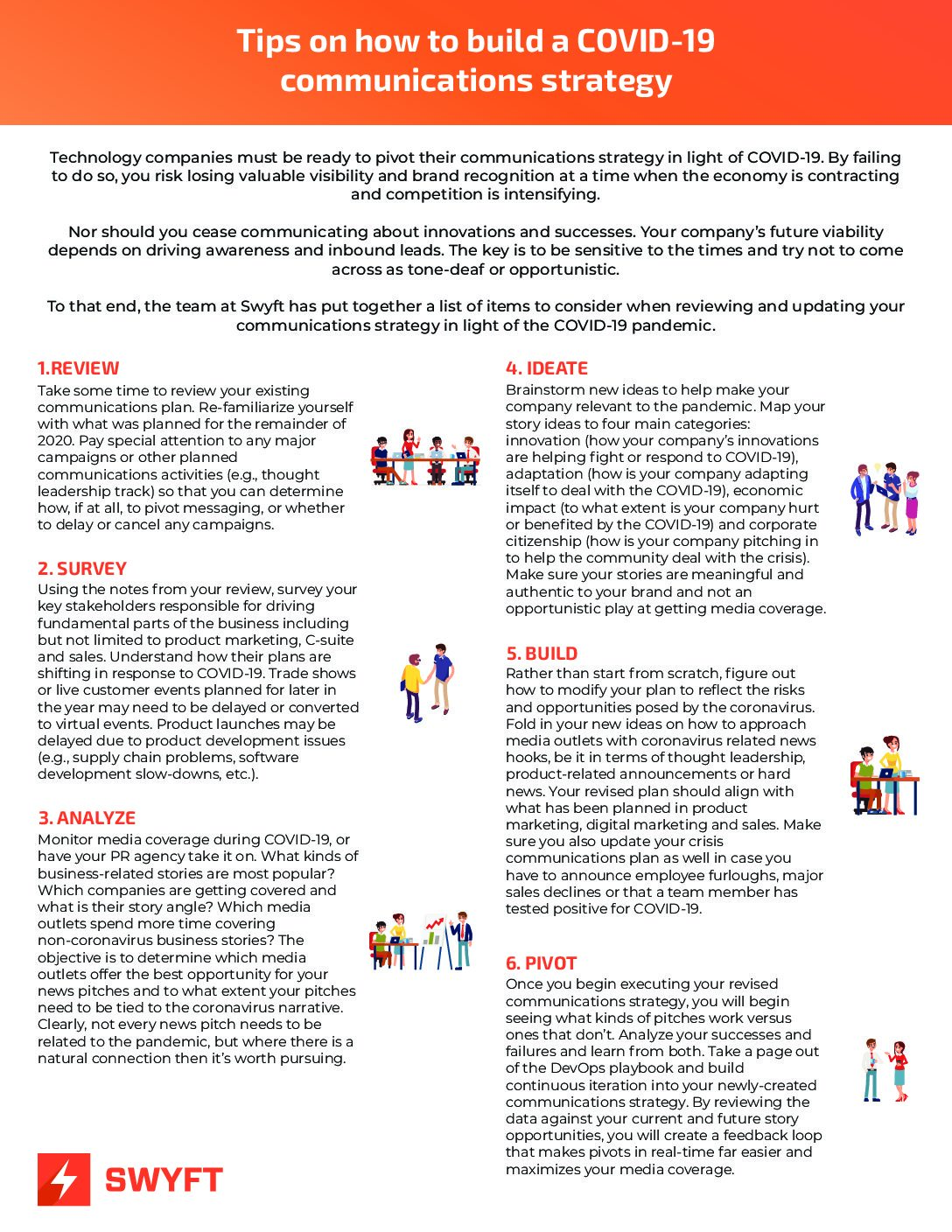Technology companies must be ready to pivot their PR strategy in light of COVID-19. By failing to do so, you risk losing valuable visibility and brand recognition at a time when the economy is contracting and competition is intensifying.
Nor should you cease communicating about innovations and successes. Your company’s future viability depends on driving awareness and inbound leads. The key is to be sensitive to the times and try not to come across as tone-deaf or opportunistic.
To that end, the team at Swyft has put together a list of items to consider when reviewing and updating your PR strategy in light of the COVID-19 pandemic.
Review
Take some time to review your existing communications plan. Re-familiarize yourself with what was planned for the remainder of 2020. Pay special attention to any major campaigns or other planned communications activities (e.g., thought leadership track) so that you can determine how, if at all, to pivot messaging, or whether to delay or cancel any campaigns.
Survey
Using the notes from your review, survey your key stakeholders responsible for driving fundamental parts of the business including but not limited to product marketing, C-suite and sales. Understand how their plans are shifting in response to COVID-19. Trade shows or live customer events planned for later in the year may need to be delayed or converted to virtual events. Product launches may be delayed due to product development issues (e.g., supply chain problems, software development slow-downs, etc.).
Analyze
Monitor media coverage during COVID-19, or have your PR agency take it on. What kinds of business-related stories are most popular? Which companies are getting covered and what is their story angle? Which media outlets spend more time covering non-coronavirus business stories? The objective is to determine which media outlets offer the best opportunity for your news pitches and to what extent your pitches need to be tied to the coronavirus narrative. Clearly, not every news pitch needs to be related to the pandemic, but where there is a natural connection then it’s worth pursuing.
Ideate
Brainstorm new ideas to help make your company relevant to the pandemic. Map your story ideas to four main categories: innovation (how your company’s innovations are helping fight or respond to COVID-19), adaptation (how is your company adapting itself to deal with the COVID-19), economic impact (to what extent is your company hurt or benefited by the COVID-19) and corporate citizenship (how is your company pitching in to help the community deal with the crisis). Make sure your stories are meaningful and authentic to your brand and not an opportunistic play at getting media coverage.
Build
Rather than start from scratch, figure out how to modify your plan to reflect the risks and opportunities posed by the coronavirus. Fold in your new ideas on how to approach media outlets with coronavirus related news hooks, be it in terms of thought leadership, product-related announcements or hard news. Your revised plan should align with what has been planned in product marketing, digital marketing and sales. Make sure you also update your crisis communications plan as well in case you have to announce employee furloughs, major sales declines or that a team member has tested positive for COVID-19.
Pivot
Once you begin executing your revised communications strategy, you will begin seeing what kinds of pitches work versus ones that don’t. Analyze your successes and failures and learn from both. Take a page out of the DevOps playbook and build continuous iteration into your newly-created communications strategy. By reviewing the data against your current and future story opportunities, you will create a feedback loop that makes pivots in real-time far easier and maximizes your media coverage.

